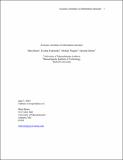| dc.contributor.author | Breen, Mara | |
| dc.contributor.author | Fedorenko, Evelina G. | |
| dc.contributor.author | Wagner, Michael | |
| dc.contributor.author | Gibson, Edward A. | |
| dc.date.accessioned | 2011-06-20T14:43:25Z | |
| dc.date.available | 2011-06-20T14:43:25Z | |
| dc.date.issued | 2010-09 | |
| dc.identifier.uri | http://hdl.handle.net/1721.1/64494 | |
| dc.description.abstract | This paper reports three studies aimed at addressing three questions about the acoustic correlates of information structure in English: (1) do speakers mark information structure prosodically, and, to the extent they do; (2) what are the acoustic features associated with different aspects of information structure; and (3) how well can listeners retrieve this information from the signal? The information structure of subject-verb-object sentences was manipulated via the questions preceding those sentences: elements in the target sentences were either focused (i.e., the answer to a wh-question) or given (i.e., mentioned in prior discourse); furthermore, focused elements had either an implicit or an explicit contrast set in the discourse; finally, either only the object was focused (narrow object focus) or the entire event was focused (wide focus). The results across all three experiments demonstrated that people reliably mark (1) focus location (subject, verb, or object) using greater intensity, longer duration, and higher mean and maximum F0, and (2) focus breadth, such that narrow object focus is marked with greater intensity, longer duration, and higher mean and maximum F0 on the object than wide focus. Furthermore, when participants are made aware of prosodic ambiguity present across different information structures, they reliably mark focus type, so that contrastively focused elements are produced with greater intensity, longer duration, and lower mean and maximum F0 than noncontrastively focused elements. In addition to having important theoretical consequences for accounts of semantics and prosody, these experiments demonstrate that linear residualisation successfully removes individual differences in people's productions thereby revealing cross-speaker generalisations. Furthermore, discriminant modelling allows us to objectively determine the acoustic features that underlie meaning differences. | en_US |
| dc.language.iso | en_US | |
| dc.publisher | Taylor & Francis | en_US |
| dc.relation.isversionof | http://dx.doi.org/10.1080/01690965.2010.504378 | en_US |
| dc.rights | Creative Commons Attribution-Noncommercial-Share Alike 3.0 | en_US |
| dc.rights.uri | http://creativecommons.org/licenses/by-nc-sa/3.0/ | en_US |
| dc.source | Prof. Gibson via Lisa Horowitz | en_US |
| dc.title | Acoustic Correlates of Information Structure. | en_US |
| dc.type | Article | en_US |
| dc.identifier.citation | Breen, Mara et al. “Acoustic Correlates of Information Structure.” Language and Cognitive Processes 25.7 (2010) : 1044 - 1098. | en_US |
| dc.contributor.department | Massachusetts Institute of Technology. Department of Brain and Cognitive Sciences | en_US |
| dc.contributor.department | McGovern Institute for Brain Research at MIT | en_US |
| dc.contributor.approver | Gibson, Edward A. | |
| dc.contributor.mitauthor | Fedorenko, Evelina G. | |
| dc.contributor.mitauthor | Gibson, Edward A. | |
| dc.relation.journal | Language and Cognitive Processes | en_US |
| dc.eprint.version | Author's final manuscript | en_US |
| dc.type.uri | http://purl.org/eprint/type/JournalArticle | en_US |
| eprint.status | http://purl.org/eprint/status/PeerReviewed | en_US |
| dspace.orderedauthors | Breen, Mara; Fedorenko, Evelina; Wagner, Michael; Gibson, Edward | en |
| dc.identifier.orcid | https://orcid.org/0000-0003-3823-514X | |
| dc.identifier.orcid | https://orcid.org/0000-0002-5912-883X | |
| mit.license | OPEN_ACCESS_POLICY | en_US |
| mit.metadata.status | Complete | |

